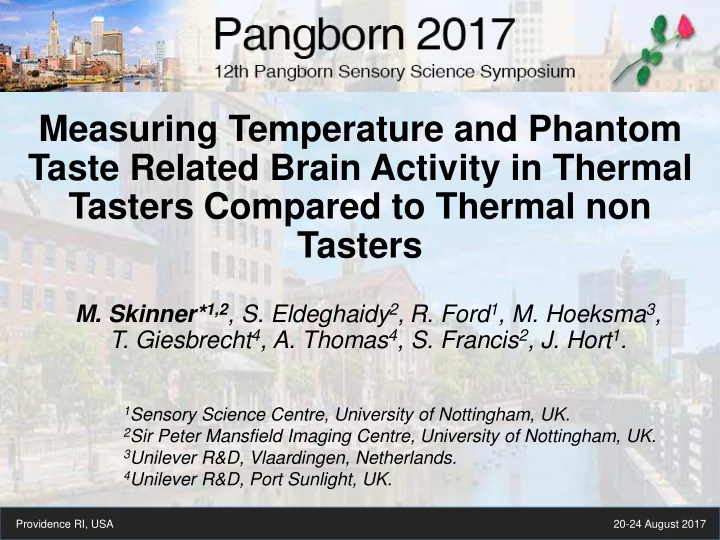

Measuring Temperature and Phantom Taste Related Brain Activity in Thermal Tasters Compared to Thermal non Tasters M. Skinner* 1,2 , S. Eldeghaidy 2 , R. Ford 1 , M. Hoeksma 3 , T. Giesbrecht 4 , A. Thomas 4 , S. Francis 2 , J. Hort 1 . 1 Sensory Science Centre, University of Nottingham, UK. 2 Sir Peter Mansfield Imaging Centre, University of Nottingham, UK. 3 Unilever R&D, Vlaardingen, Netherlands. 4 Unilever R&D, Port Sunlight, UK. Providence RI, USA 20-24 August 2017
What is thermal taster status? Bitter • Metallic Sweet • Minty COOLING stimuli • Spicy WARMING stimuli • Umami Sour (Yang et al. , 2014) Salt (Cruz & Green, 2000) Food Choice? Up to Thermal taste phenotypes 50% TTs • Thermal taster (TT) • Thermal non taster (TnT) TTs are more sensitive to oral stimuli • Taste • Trigeminal (Green & George, 2004, Yang et al ., 2014) 2
Exploring thermal taste phenotypes Multidisciplinary approach Sensory Science & functional Magnetic Resonance Imaging (fMRI) • Perceptual response Captured by sensory evaluation techniques • Brain activation Captured by fMRI techniques • Brain activation maps show areas of the • brain involved in the response to a stimulus 3
Study aims Identify mechanisms involved in the phantom taste response? Perceptual response Can we identify the temperature range at which phantom • taste is perceived during temperature stimulation? Does this differ across TTs? • Brain response Do we see activation in the gustatory cortex when phantom • taste is reported by TTs? Is there a difference in temperature related brain activation in • the somatosensory cortex across thermal taste phenotypes? 4
Thermal taste phenotyping Classify TTs/TnTs (Bajec and Pickering, 2008) • Measure perceived temperature intensity • Warming trial Cooling trial 2 replicates Recruited General labelled magnitude scale 12 TTs/12 TnTs • (gLMS) 5
Modified phantom taste testing 5°C trial 40°C trial Rating Rating Temporal taste response 10 replicates 6
Phenotyping Results Cooling trial Warming trial (Cruz and Green, 2000) (Yang et al. , 2014) 7
Reproducibility of phantom taste Taste intensity rating Phantom taste is reproducibly reported across replicates • Phantom taste is perceived at a specific temperature range • 8
Inter-individual responses (TTs) Mean of 10 replicates Taste intensity ratings 9
Inter-individual responses (TTs) Taste intensity ratings Mean of 10 replicates The temperature range at which phantom taste is perceived is highly variable across TTs 10
fMRI brain imaging • 3 T Philips Achieva scanner, 32-element SENSE head coil • fMRI data acquired with double-echo gradient EPI (TE: 20 ms, 45 ms), 3mm3 isotropic voxel size, 36 transverse slices, TR = 2.5 s 11
fMRI testing Subject 08 40°C trial gLMS intensity rating Control task Time (sec) 5°C trial Subject 08 gLMS intensity rating Temperature ( ° C) Time (sec) 12
Phantom taste related brain activation (12 TTs) Brain activation in regions associated with taste processing in TTs Taste cortex (anterior insula) Are gustatory nerve fibres activated by temperature in TTs? Is ‘phantom’ taste really a phantom? fMRI data analysed by Dr Sally Eldeghaidy-Sir Peter Mansfield Imaging Centre, UoN 13
Temperature response across thermal taste phenotypes (12 TTs & 12 TnTs) Oral somatosensory Cortical activation TTs > TnTs areas TTs have greater temperature related brain activation than TnTs fMRI data analysed by Dr Sally Eldeghaidy-Sir Peter Mansfield Imaging Centre, UoN 14
Conclusions • The temperature range at which TTs perceive phantom taste during thermal stimulation is variable • Brain regions associated with taste processing are activated in response to temperature stimulation in TTs, accounting for the perceived ‘phantom’ taste • TTs have greater temperature related brain activation in oral somatosensory areas of the brain than TnTs These findings support the hypothesis that cross wiring between gustatory and trigeminal nerve fibres innervating the papillae may be involved (Cruz and Green, 2000, Hort et al, 2016) 15
Implications and future directions Implications • Impact of TT status on product perception, food choice, nutritional status and health outcomes • Heightened oral sensitivity exhibited by TTs • Phantom tastes perceived Future directions • Mechanisms associated with thermal taster status • Isolate the temperature range of phantom taste responses • Understanding non- prototypical ‘taste’ sensations • Utilising fMRI to understand cortical processing 16
Thank you for your attention! Acknowledgments SPMIC SSC Unilever • Joanne Hort • Susan Francis • Anna Thomas • Rebecca Ford • Sally Eldeghaidy • Timo Giesbrecht • Martha Skinner • Marco Hoeksma www.nottingham.ac.uk/biosciences/research/research-themes/taste-map/taste-map.aspx 17
Recommend
More recommend